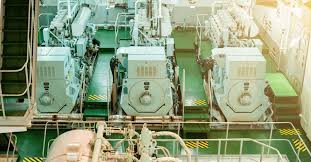Electrical Generator Synchronizing System
Key Components and Working:
Synchronizer Panel: The synchronizer panel is the central control unit responsible for managing the synchronization process. It monitors the frequency, voltage, and phase angle of each generator in comparison to the grid or the reference source.
Speed and Voltage Matching: Before synchronization, the speed and voltage levels of the incoming generator are adjusted to match those of the grid or the busbar system. This is crucial to ensure a smooth and stable synchronization process.
Phase Angle Synchronization: The phase angle of the incoming generator is carefully adjusted to align with the reference source. The goal is to bring the generator's output waveform in phase with the grid or the busbar system.
Dead Bus Closing: Once the incoming generator's frequency, voltage, and phase angle are closely matched to the grid or the busbar system, a dead bus closing is initiated. This involves connecting the generator to the common busbar system.
Active Power Sharing: After synchronization, the generators work in parallel, sharing the active power load proportionately based on their capacity ratings. The synchronizer panel continuously monitors and adjusts the active power sharing among the connected generators to maintain balance and stability.
Load Sharing and Frequency Control: The synchronizer system also manages load sharing and frequency control among the connected generators. If there is a change in the load demand, the system automatically adjusts the power output of each generator to maintain a stable grid frequency.
Increased Power Capacity: Synchronizing multiple generators allows them to operate together as a single larger unit, providing increased power capacity for the grid or the load.
Redundancy and Reliability: By synchronizing multiple generators, the system gains redundancy. If one generator fails, the others can pick up the load, ensuring continuous power supply and enhanced reliability.
Efficient Load Sharing: The synchronizing system ensures efficient load sharing among the generators, preventing overloading of any particular unit and optimizing fuel consumption.
Grid Stability: Synchronized generators contribute to grid stability by maintaining a constant frequency and voltage levels, crucial for sensitive electrical equipment's proper functioning.
Conclusion:
The Electrical Generator Synchronizing System plays a vital role in the efficient and reliable operation of power generation systems. By synchronizing multiple generators, this system enables them to work harmoniously, contributing their power to the grid or the load in a coordinated and controlled manner. This synchronization process ensures a stable and continuous power supply, making it a fundamental component of modern power generation and distribution systems.








0 Comments